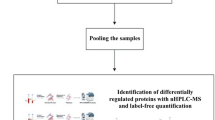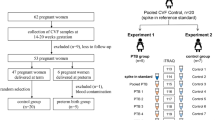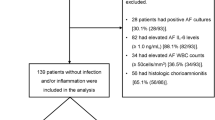Abstract
Early miscarriage (EM) is one of the most devastating obstetrical complications globally affecting the quality of women’s life. In the present study, we aimed to identify proteins that correlate with and could act as biomarkers for EM. We performed 2-dimensional gel electrophoresis in chorionic villi samples followed by mass spectrometry for identification of differential protein expression with EM. Proteomic studies detected a total 124 protein spots, out of which 83 spots were differentially expressed between EM and controls in chorionic villi samples. Matrix assisted laser desorbtion/ionization-time of flight (MALDI-TOF) mass spectrometry analysis revealed Apolipoprotein A1 (APOA1) to be the most upregulated protein in the EM group that was validated by Western blotting and Enzyme-linked immunosorbent assay (ELISA) . We found low but not statistically significant level of APOA1 on 21st day of menstruation in comparison to the 7th day. APOA1 level was observed to be the lowest in the first trimester. Hence, this study suggests that low APOA1 expression is critical in establishing pregnancy and elevated APOA1 expression in chorionic villi correlates with EM. Similar observation in serum samples suggests its potential as a marker for the risk of EM.
Similar content being viewed by others

References
Rambaldi MP, Mecacci F, Paidas MJ. Evaluation and management of recurrent pregnancy loss. Placenta. 2011;32:S278.
Giakoumelou S, Wheelhouse N, Cuschieri K, Entrican G, Howie SE, Horne AW. The role of infection in miscarriage. Hum Reprod Update. 2015;22(1):116–133.
Jauniaux E, Burton GJ. Pathophysiology of histological changes in early pregnancy loss. Placenta. 2005;26(2):114–123.
Everett C. Incidence and outcome of bleeding before the 20th week of pregnancy: prospective study from general practice. BMJ. 1997;315(7099):32–34.
Rai R, Regan L. Recurrent miscarriage. Lancet. 2006;368(9535):601–611.
Li P, Shi Y, Shuai H, et al. Alterted SLIT2/ROBO1 signalling is linked to impaired placentation of missed and threatened miscarriage in early pregnancy. Histopathology. 2017;71(4):543–552.
Çöl-Madendag I, Madendag Y, Altinkaya SÖ, Bayramoglu H, Danisman N. The role of VEGF and its receptors in the etiology of early pregnancy loss. Gynecol Endocrinol. 2014;30(2):153–156.
Nair RR, Khanna A, Singh K. Association of increased S100A8 serum protein with early pregnancy loss. Am J Reprod Immunol. 2015;73(2):91–94.
Calleja-Agius J, Jauniaux E, Muttukrishna S. Placental villous expression of TNFα and IL-10 and effect of oxygen tension in euploid early pregnancy failure. Am J Reprod Immunol. 2012;67(6):515–525.
Sharp AN, Heazell AE, Crocker IP, Mor G. Placental apoptosis in health and disease. Am J Reprod Immunol. 2010;64(3);159–169.
Jenkins C, Wilson R, Roberts J, Miller H, McKillop JH, Walker JJ. Antioxidants: their role in pregnancy and miscarriage. Antioxid Redox Signal. 2000;2(3);623–628.
Toth B, Jeschke U, Rogenhofer N, Scholz C, Würfel W, Thaler CJ, Makrigiannakis A. Recurrent miscarriage: current concepts in diagnosis and treatment. J Reprod Immunol. 2010;85(1):25–32.
Liu AX, Jin F, Zhang WW, et al. Proteomic analysis on the alteration of protein expression in the placental villous tissue of early pregnancy loss. Biol Reprod. 2006;75(3):414–420.
Xin L, Xu B, Ma L, et al. Proteomics study reveals that the dysregulation of focal adhesion and ribosome contribute to early pregnancy loss. Proteomics Clin Appl. 2016;10(5):554–563.
Ni X, Li X, Guo Y, et al. Quantitative proteomics analysis of altered protein expression in the placental villous tissue of early pregnancy loss using isobaric tandem mass tags. Biomed Res Int. 2014;2014:647143.
Swain M, Ross NW. A silver stain protocol for proteins yielding high resolution and transparent background in sodium dodecyl sulfate-polyacrylamide gels. Electrophoresis. 1995;16(6):948–951.
Towbin H, Staehelin T, Gordon J. Electrophoretic transfer of proteins from polyacrylamide gels to nitrocellulose sheets: procedure and some applications. Proc Natl Acad Sci U S A. 1979;76(9):4350–4354.
Brosens JJ, Hodgetts A, Feroze-Zaidi F, et al. Proteomic analysis of endometrium from fertile and infertile patients suggests a role for apolipoprotein AI in embryo implantation failure and endometriosis. Mol Hum Reprod. 2009;16(4):273–285.
Park JS, Oh KJ, Norwitz ER, et al. Identification of proteomic biomarkers of preeclampsia in amniotic fluid using SELDI-TOF mass spectrometry. Reprod Sci. 2008:15(5):457–468.
Mains LM, Christenson L, Yang B, et al. Identification of apolipoprotein A1 in the human embryonic secretome. Fertil Steril. 2011;96(2):422–427.
Amjadi F, Aflatoonian R, Javanmard SH, Saifi B, Ashrafi M, Mehdizadeh M. Apolipoprotein A1 as a novel anti-implantation biomarker in polycystic ovary syndrome: a case-control study. J Res Med Sci. 2015;20(11):1039.
Donaghay M, Lessey BA. Uterine receptivity: alterations associated with benign gynecological disease. Semin Reprod Med. 2007;25(6):461–475. © Thieme Medical Publishers.
Blesa D, Ruiz-Alonso M, Simón C. Clinical management of endometrial receptivity. Semin Reprod Med. 2014;32(5):410–413. Thieme Medical Publishers.
Psychoyos A. Hormonal control of ovoimplantation. Vitam Horm. 1973;31:201–256. Academic Press.
Li N, Long Y, Fan X, et al. Proteomic analysis of differentially expressed proteins in hepatitis B virus-related hepatocellular carcinoma tissues. J Exp Clin Cancer Res. 2009;28(1):122.
Kozak KR, Su F, Whitelegge JP, Faull K, Reddy S, Farias-Eisner R. Characterization of serum biomarkers for detection of early stage ovarian cancer. Proteomics. 2005;5(17):4589–4596.
Yang JW, Czech T, Gelpi E. Extravasation of plasma proteins can confound interpretation of proteomic studies of brain: a lesson from apo AI in mesial temporal lobe epilepsy. Mol Brain Res. 2005;139(2):348–356.
Ai J, Tan Y, Ying W, et al. Proteome analysis of hepatocellular carcinoma by laser capture microdissection. Proteomics. 2006;6(2):538–546.
Cortón M, Botella-Carretero JI, López JA, et al. Proteomic analysis of human omental adipose tissue in the polycystic ovary syndrome using two-dimensional difference gel electrophoresis and mass spectrometry. Human Reproduction. 2008;23(3):651–661.
Giusti L, Iacconi P, Ciregia F, et al. Fine-needle aspiration of thyroid nodules: proteomic analysis to identify cancer biomarkers. J Proteome Res. 2008;7(9):4079–4088.
Trocmé C, Marotte H, Baillet A, et al. Apolipoprotein AI and platelet factor 4 are biomarkers for infliximab response in rheumatoid arthritis. Ann Rheum Dis. 2009;68(8):1328–1333.
Rødgaard T, Heegaard PM, Callesen H. Non-invasive assessment of in-vitro embryo quality to improve transfer success. Reprod Biomed Online. 2015;31(5):585–592.
Baardman ME, Kerstjens-Frederikse WS, Berger RM, Bakker MK, Hofstra RM, Plösch T. The role of maternal-fetal cholesterol transport in early fetal life: current insights. Biol Reprod. 2013;88(1):24.
Brunham LR, Kruit JK, Iqbal J, et al. Intestinal ABCA1 directly contributes to HDL biogenesis in vivo. J Clin Invest. 2006;116(4):1052–1062.
Nyalwidhe J, Burch T, Bocca S, et al. The search for biomarkers of human embryo developmental potential in IVF: a comprehensive proteomic approach. Mol Hum Reprod. 2013;19(4):250–263.
Deutsch DR, Fröhlich T, Otte KA, et al. Stage-specific proteome signatures in early bovine embryo development. J Proteome Res. 2014;13(10):4363–4376.
Brett KE, Ferraro ZM, Yockell-Lelievre J, Gruslin A, Adamo KB. Maternal—fetal nutrient transport in pregnancy pathologies: the role of the placenta. Int J Mol Sci. 2014;15(9):16153–16185.
Chen X, Scholl TO, Stein TP, Steer RA, Williams KP. Maternal circulating lipid profile during early pregnancy: racial/ethnic differences and association with spontaneous preterm delivery. Nutrients. 2017;9(1):E19.
Zamanian-Daryoush M, Lindner D, Tallant TC, et al. The cardioprotective protein apolipoprotein A1 promotes potent anti-tumorigenic effects. J Biol Chem. 2013;288(29):21237–21252.
Nair RR, Sinha P, Khanna A, Singh K. Reduced myeloid-derived suppressor cells in the blood and endometrium is associated with early miscarriage. Am J Reprod Immunol. 2015 73(6):479–486.
Köstlin N, Hofstädter K, Ostermeir AL, et al. Granulocytic myeloid-derived suppressor cells accumulate in human placenta and polarize toward a Th2 phenotype. J Immunol. 2016;196(3):1132–1145.
Challis JR, Lockwood CJ, Myatt L, Norman JE, Strauss JF III, Petraglia F. Inflammation and pregnancy. Reprod Sci. 2009;16(2):206–215.
Shariefa M, Mohammed R, Shani W. The role of Th1 and Th2 cytokines among women with recurrent spontaneous miscarriage. Scientific J Med Sci. 2014;3(7):345–351.
Makhseed M, Raghupathy R, Azizieh F, Omu A, Al-Shamali E, Ashkanani L. Th1 and Th2 cytokine profiles in recurrent aborters with successful pregnancy and with subsequent abortions. Hum Reprod. 2001;16(10):2219–2226.
Lashen H, Fear K, Sturdee DW. Obesity is associated with increased risk of first trimester and recurrent miscarriage: matched case-control study. Hum Reprod. 2004;19(7):1644–1646.
Metwally M, Saravelos SH, Ledger WL, Li TC. Body mass index and risk of miscarriage in women with recurrent miscarriage. Fertil Steril. 2010:94(1):290–295.
Author information
Authors and Affiliations
Corresponding author
Additional information
Authors’ Note
The human related work was done at the Department of Molecular & Human Genetics, Banaras Hindu University, Varanasi 21005, India. Priyanka Verma and Rohini R. Nair contributed equally to this work. R.R.N. performed and analyzed the experiment shown in Figure 1. P.V. performed and analyzed the experiments shown in Figure 2. A.K. provided the human tissue and blood samples. S.S. and S.R. helped in the preparation of manuscript. K.S. and R.K.J. designed and coordinated the study design and finalized the manuscript. All authors reviewed the results and approved the final version of the manuscript. Priyanka Verma and Rohini R.Nair are contributing equally for the manuscript that has been mentioned in the original version.
Rights and permissions
About this article
Cite this article
Verma, P., Nair, R.R., Singh, S. et al. High Level of APOA1 in Blood and Maternal Fetal Interface Is Associated With Early Miscarriage. Reprod. Sci. 26, 649–656 (2019). https://doi.org/10.1177/1933719118783266
Published:
Issue Date:
DOI: https://doi.org/10.1177/1933719118783266



